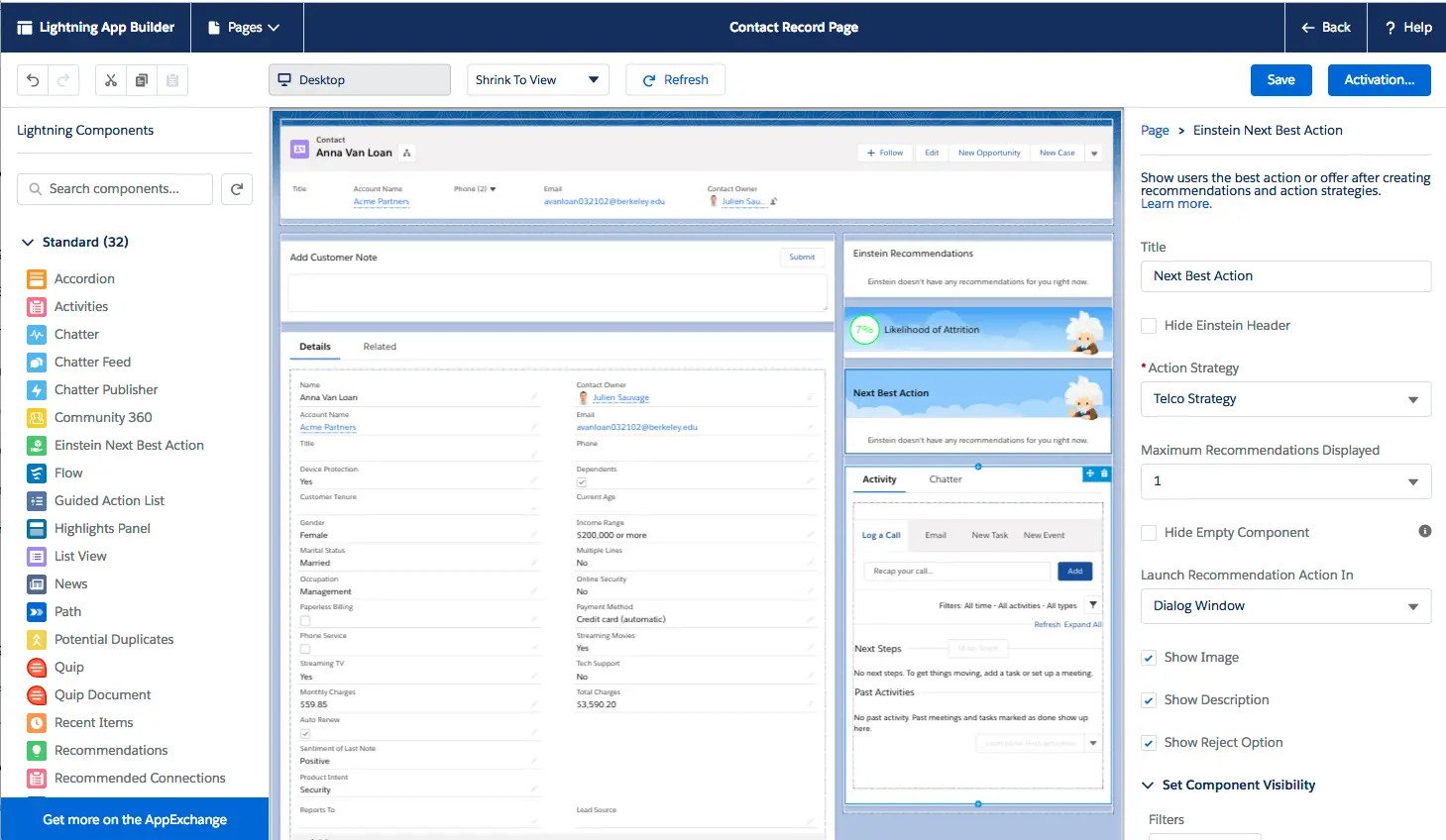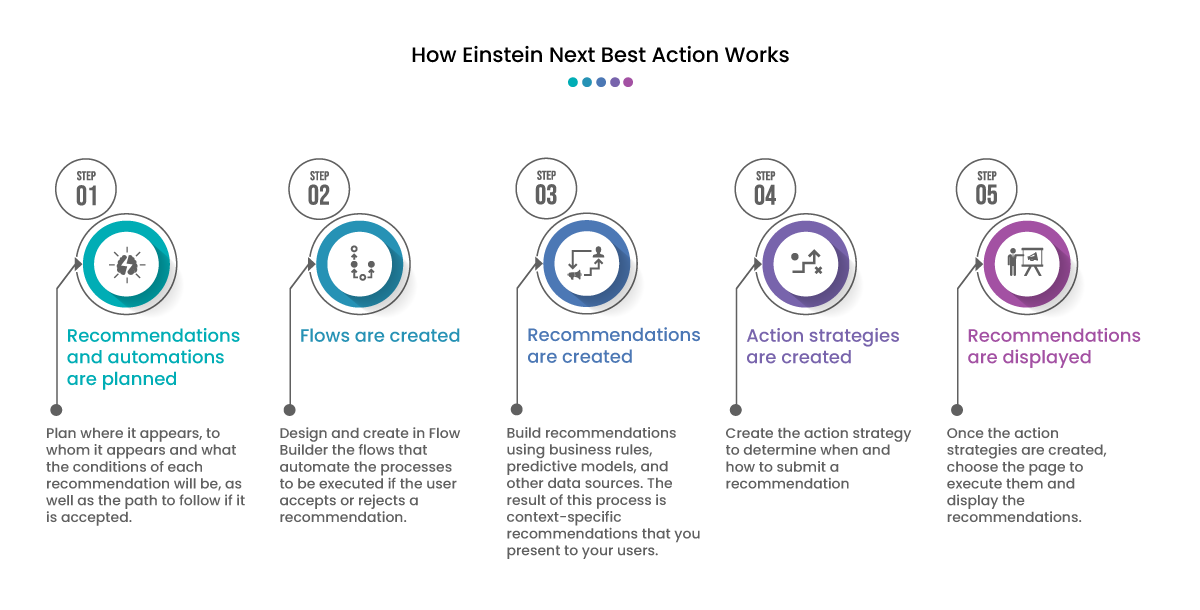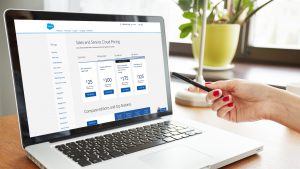Efficiency is crucial for any organization aspiring to stay competitive. In this context, Salesforce stands out with Einstein Next Best Action (ENBA), a tool designed to optimize workflows.
ENBA displays personalized recommendations based on flow creation, action strategies, and branching logic created through specific business rules of organizations. These recommendations can be shown on Lightning pages, Visualforce, Experience Cloud sites, and external sites using the ENBA component or the suggested actions component. With the ability to accept or reject recommendations, users have full control, optimizing both the customer and agent experience.
Next, we’ll detail how it works, its use cases, and the benefits of this solution for organizations. Let’s dive in.
What is Einstein Next Best Action?
Imagine your company is in the midst of an interaction with a customer requesting a specific service. The attending agent analyzes their request and conditions, engaging in a seamless exchange with the customer. Every action the agent takes during the interaction must consider the customer information your company already knows from their history, ensuring the optimal response. Even if the responsible agent doesn’t have all this information, they must provide the best possible response—most convenient for that customer at that moment. How do they do it? With the help of Einstein Next Best Action, positioned as the agent’s best ally to address the needs of that customer. And the best part is that its action is not limited exclusively to this scenario.
Einstein Next Best Action (ENBA) is a process automation tool that provides personalized suggestions on the next best actions to take in each case. Recommendations are generated in real-time, based on big data and predictive analytics for personalization. ENBA focuses on areas that have customer interaction, especially service agents.
By configuring business rules and filters based on business logic, it obtains the best contextual suggestions. Essentially, the primary goal of Einstein Next Best Action is to offer the right action to the right person at the right time. On one hand, this functionality helps agents receive recommendations for the best actions to enhance their work. On the other hand, customers also receive recommendations in communities based on their interactions.
In summary, this proactive approach allows organizations to provide personalized experiences and increase operational efficiency. Furthermore, it drives customer engagement and satisfaction.

Let’s remember the basic functioning of Einstein Next Best Action.
ENBA can be configured without the need for coding, simply through clicks, making it user-friendly for various types of users. To generate recommendations that are highly tailored to diverse situations, it is necessary to follow a series of steps:
In practice, this translates to:
- Data Collection: The system collects real-time historical and contextual data from various sources, such as previous interactions, customer preferences, and transactional data.
- Predictive Analysis: It uses machine learning models to identify patterns and behaviors in the collected data. These models enable the generation of possible future actions.
- Context Evaluation: It considers elements of the real context, such as the nature of the interaction, customer location, and other relevant factors, to personalize recommendations.
- Recommendation Generation: Based on the analysis and context evaluation, the system generates specific recommendations for the next action to take, whether it’s an offer, a message, or a suggestion.
- Real-time Implementation: It presents proactive recommendations in real-time during the interaction with the customer.
- Continuous Optimization: As more data is collected and feedback is obtained, the system continuously adjusts its models to improve the accuracy and relevance of recommendations.

Understanding this, it’s then possible to know the key steps required for a successful implementation of ENBA. These steps structure how recommendations will be presented, as well as the sequence of steps in case they are accepted or rejected. In broad terms:
- Creation of Automated Flows: Using Flow Builder, action flows are created to be executed when a suggested action is accepted or rejected by the user.
- Recommendation Creation: Here, a record of recommendations is created, designing how they will be displayed to the user.
- Strategy Flow Creation: Also using Flow Builder, recommendation strategy flow types are created, deciding which recommendation is shown and when it is presented.
- Recommendation Presentation: Once all the elements involved in formulating a recommendation are created, it’s necessary to display it, either on the Lightning page, Experience Cloud, or an external site.
- Analysis: At this point, metrics are generated on the adoption of recommendations by users to contribute systematically to strategy improvements.
These recommendations can be displayed on different pages, including Lightning pages, Visualforce, Experience Cloud sites, and external sites. The visualization is done through these components:
- Einstein Next Best Action Component: This component displays recommendations to agents on most Lightning pages, including record pages, home pages, and application pages.
- Suggested Actions Component: This component can be used to display recommendations on websites built in Experience Cloud, using strategies created in Strategy Builder.

Need Salesforce Consulting Services?
We offer Salesforce consulting services aimed to kickstart your company’s growth, either by implementing a new business-tailored solution or improving an existing implementation.
Use Cases of Einstein Next Best Action
Different departments within a company can experience the advantage of using ENBA functionality. Some of the most evident cases include:
- Sales: Facilitates valuable suggestions based on previous knowledge, providing guidance on how to approach customers. This enables the identification and targeting of potential customers, as well as real sales opportunities. For example, it can recommend specific offers based on the customer’s purchase history, preferences, and past behaviors. It also provides recommendations on the best customer follow-up actions, such as follow-up calls or the sending of promotional materials.
- Service: Offers suggestions to efficiently resolve issues during service interactions, improving customer satisfaction. It provides recommendations on product or service upgrade offers during technical support conversations.
- Commerce: Makes highly personalized product suggestions based on purchase history, individual preferences, and user behavior on the website. It dynamically adjusts the user experience by displaying content, promotions, or product recommendations based on past behavior. This approach not only enhances the shopping experience by presenting relevant options but also boosts sales by increasing conversion chances.
- Marketing: Provides marketing agents with suggestions on the best actions to take in each campaign, based on the target audience. These recommendations are generated considering previous interactions with that audience and available information about their likes and preferences. It also contributes to dynamic audience segmentation for marketing campaigns, suggesting criteria based on user behavior. It recommends the most relevant content for each user in email campaigns, digital advertising, and other marketing strategies.
These use cases demonstrate how ENBA is a versatile tool that strengthens decision-making and elevates the quality of interactions in various business contexts. It’s worth noting that ENBA comes with a free monthly allocation of 5,000 requests. If this number is exceeded, Salesforce will contact the company to agree on a usage price.
In summary, how does Einstein Next Best Action help businesses?
We wanted to emphasize how the benefits and features materialize, helping businesses increase their productivity. In this regard, we can affirm that ENBA:
- Is a ready-to-use tool.
- Can be configured or customized to the needs of each company.
- Is considered a recommendation engine powered with artificial intelligence (AI) and machine learning that helps make the best decisions at each moment.
- Offers optimal recommendations for agents, partners, and customers in real-time to achieve maximum impact.
- Tailors’ recommendations to the collected data.
- Combines powerful predictive models and each company’s business rules to make recommendations.
- Automates actions based on recommendations, saving agents time for more valuable tasks. For example, ENBA saves up to 50% of the time when onboarding new customers or agents. Additionally, in sales, it saves up to 88% of the time by presenting personalized offers to customers.
- Unifies information from its data sources, both from Salesforce and external sources.
- Provides valuable and useful information.
- The system updates and continues to learn constantly based on feedback received, depending on the acceptance or rejection of the suggestions made, as well as new available data. This, in turn, allows recommendations to become increasingly accurate and relevant.
- Suggestions empower agents to make the best decisions and act quickly.
- Integrates seamlessly with other AI tools, such as Einstein Recommendation Builder.
Without a doubt, having an ally to make your work more agile and efficient is always an advantage. Therefore, ENBA is one of the tools that is highly popular among different audiences. Its recommendations, tailored to each situation and based on accurate data and information, make its suggestions very helpful for agents. Ultimately, these qualities of ENBA translate into productivity, satisfied customers, and increased revenue. If you want to explore this functionality further, you can contact the SkyPlanner team at hello@theskyplanner.com. We will be delighted to guide you on this journey.



